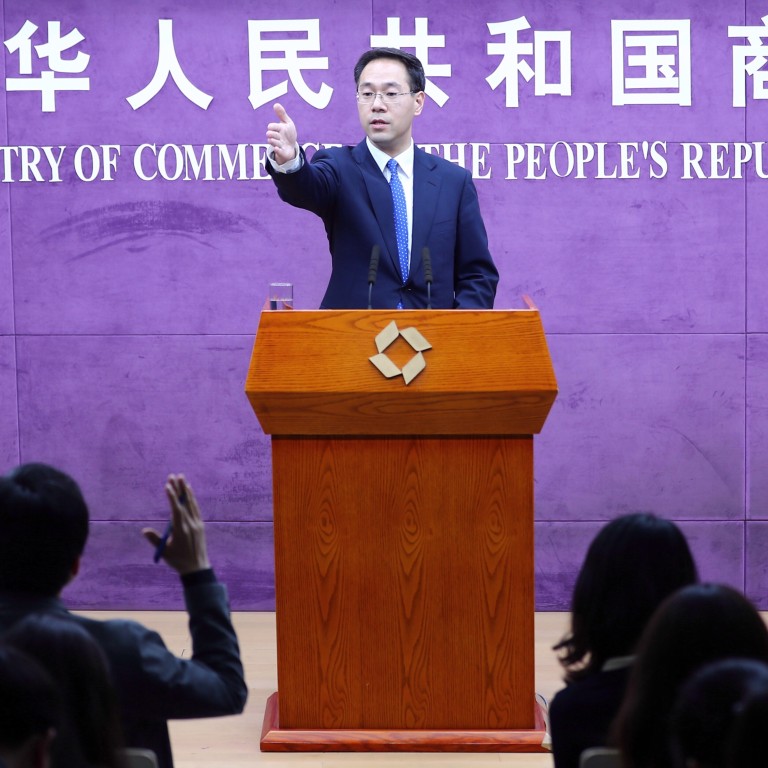
China ridicules US basis for tariffs, saying ‘real’ trade imbalance is only a third of what Donald Trump claims
- Commerce Ministry report shows trade deficit between the world’s two largest economies just 37 per cent of the figure published by the US government
- China and the United States are set to send delegations to a meeting of G20 trade ministers later this week in Japan
China’s “real” trade surplus with the United States is only about a third of the figure published by Washington, according to the Ministry of Commerce, in Beijing’s latest move to undercut the economic foundation for US President Donald Trump’s tariffs on Chinese products.
US Commerce Department figures show that the US had a US$419 billion deficit with China in 2018, while China’s customs data showed a surplus of US$323 billion.
However, in a statement published on Thursday, China’s Commerce Ministry argued that including the services trade and adjusting for processing trade, the gap would only be US$153 billion, or just 37 per cent of the headline figure published by the US government.
The ministry argued that in the processing trade – Chinese exports of products assembled from imported components – the valued added to the product by China is only a fraction of the value used in the US calculations.
There have always been divergence between Chinese and US figures on the bilateral trade gap due to different methods used, but the variation has generally been in the region of 20 per cent.
Beijing is challenging Washington’s contention that China is taking advantage of the US and, therefore, the US has good reason to impose tariffs on Chinese imports, according to the ministry’s 10-page report titled “US Gains in China-US trade”. It did not mention US President Trump by name.
In a separate news briefing also on Thursday, the ministry said that the White House had to correct its “wrong practices” and show sincerity if it wanted to resume negotiations to end the trade war.
There are principles in cooperation and there is a bottom line in talks. China will never give in on major issues of principle
“There are principles in cooperation and there is a bottom line in talks,” ministry spokesman Gao Feng said. “China will never give in on major issues of principle.”
Gao made no mention of a possible meeting between Trump and Chinese President Xi Jinping during the G20 summit in Osaka, Japan, this month, nor did he confirm who would be included in China’s delegation for the meeting of G20 trade ministers later this week.
“Whoever started the trouble should end it, now the ball [on trade war talks] is in the US court,” Gao added. “We will keep a close eye on what the US side says and does.
“We are actively preparing [for the G20 meeting this week] and will send a delegation at a corresponding level.”
Gao said that the latest research report, which was issued just days after China published a white paper that blamed the US for the collapsed trade talks, would help the public to better understand the true nature of China-US trade.
Restrictions imposed by the US on certain exports to China are a primary cause of the trade imbalance, the report said, noting that US export limitation measures involved about 3,100 items, mostly hi-tech products.
“If the United States were to lift its export ban against China to the same level as those applicable to France, the US trade deficit with China would narrow by a third,” the report said, citing an analysis by the Carnegie Endowment for International Peace.
China is willing to increase imports from the US, the report said, calling on Washington to relax the restrictions on exports to China and to attend China’s import expo to promote US products.
The report also cited China and US government data to argue that the US had received “substantial benefits” from economic and trade cooperation with China.
If the United States were to lift its export ban against China to the same level as those applicable to France, the US trade deficit with China would narrow by a third
The total income that American companies earned in China was US$940 billion in 2017, while the US has received a total of US$1.37 trillion worth of investment from Chinese firms and individuals during the same period, the report said.
The report blamed the Trump administration for intentionally ignoring the mutual benefits of China-US trade and triggering tensions by using the trade deficit as an excuse.
“If only one party was ‘winning’ and the other one was ‘losing’, the economic and trade cooperation between China and the US would not have lasted until today,” the report added.
In response to the accusation that China was playing a blame game for the collapse of trade talks, Gao said that it was common to adjust text contents and statements.
“The US government had done that several times in the negotiations, but blamed China for doing the same thing. That is unacceptable,” he said.
He also said trade tensions had significantly damaged the US agriculture sector, noting that China’s soybean and pork imports from the US had slumped by 70.6 per cent and 53.6 per cent, respectively, in the first four months of 2019.

